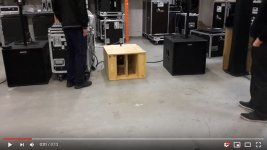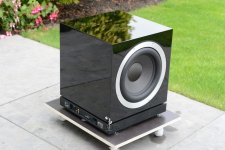Hello,
I have been researching the subject for some time;
How can I build subwoofers that reproduce low frequencies with great accuracy?
After many experiments and researches, we reached the following conclusions:
There are only a few ways.
1. Speaker controlled with accelerometer. (it is difficult to build)
2. Force cancelling, two 12 '' speakers mounted in the closed box, controlled from DSP.
3. Force cancelling, four 6,5'' speakers mounted in the closed box, controlled from DSP.
4. Ripole - ex Visaton Petit Orgue
PETIT ORGUE | Visaton
Each of these versions also has advantages and disadvantages.
Do you have experience with these designs?
I am interested in the reproduction of the low frequencies including of modern music, electronic, not only acoustic.
Spectrum to be reproduced: 20Hz - 300Hz
What do you think about these approaches?
I have been researching the subject for some time;
How can I build subwoofers that reproduce low frequencies with great accuracy?
After many experiments and researches, we reached the following conclusions:
There are only a few ways.
1. Speaker controlled with accelerometer. (it is difficult to build)
2. Force cancelling, two 12 '' speakers mounted in the closed box, controlled from DSP.
3. Force cancelling, four 6,5'' speakers mounted in the closed box, controlled from DSP.
4. Ripole - ex Visaton Petit Orgue
PETIT ORGUE | Visaton
Each of these versions also has advantages and disadvantages.
Do you have experience with these designs?
I am interested in the reproduction of the low frequencies including of modern music, electronic, not only acoustic.
Spectrum to be reproduced: 20Hz - 300Hz
What do you think about these approaches?
You've missed two of the best, basshorns and infinite baffle. They take the top two spots for me. You likely won't get sufficient output from your last two options unless you go way overboard with your driver count.
what basshorns subwoofer do you use? In my experience, they sound worse than force canceling subwoofers.
I'm looking for a bass, fast and deep.
I don't like lazy bass
what basshorns subwoofer do you use? In my experience, they sound worse than force canceling subwoofers.
I'm looking for a bass, fast and deep.
I don't like lazy bass
This:
A for Ara H2
Looks like this inside:
A for Ara H2 CAD model
It has a bigger brother too, which is my current benchmark that all others are compared with:
A for Ara H3
This:
A for Ara H2
Looks like this inside:
A for Ara H2 CAD model
It has a bigger brother too, which is my current benchmark that all others are compared with:
A for Ara H3
I understood, it looks impressive, but because of its large size it is useless in my case.
The more compact subwoofers are easier to position and integrate into the space.
For accurate small subs, servo is currently as good as it gets referenced to a full size compression horn.
GM
I agree with you, but has anyone tried to build a DIY servo subwoofer?
How can I build subwoofers that reproduce low frequencies with great accuracy?
I am interested in the reproduction of the low frequencies including of modern music, electronic, not only acoustic.
The best bass speaker I have ever heard reproducing all the minute details and "edgy" modulations of electronic music is the ROAR15 design with B&C 15SW115 drivers.
They are not small, but you get a lot of the qualities of bass horns from an easy to build design. Very high efficiency. Very detailed and they have a very rare physical reproduction where the bass is felt in the air in your listening area already at very low sound pressure levels.
It is easy to tune a ROAR15 lower, but they get a lot bigger and the physical tactile character gets quite prominent with 35 Hz tuning.
This physical and tactile reproduction is something I have never heard before from any other design except from full sized front loaded horns.
Very addictive, even though it ca be a bit strange and unnerving if you are used to more "normal" designs.
Martinsson's Blog - ROAR15
Last edited:
This physical and tactile reproduction is something I have never heard before from any other design except from full sized front loaded horns.
Very addictive, even though it ca be a bit strange and unnerving if you are used to more "normal" designs.
I very much agree with you, on how addictive physical and tactile bass reproduction is...
I routinely hear it on a number of different systems that use either FLH's, or simple bass reflex subs.
I think the three essential ingredients are exemplary phase/time alignment with the mains, high SPL/headroom throughout the spectrum, and low extension.
Given these three ingredients, I have to believe there are many sub/main designs that could provide the sensations.
I strongly believe it is a system sensation, of which the sub is one (most important) part.
I agree with you, but has anyone tried to build a DIY servo subwoofer?
Not that I'm aware of.
GM
Equing and filtering errors for alignement can lead to ripple both in time (lagging) and response curve, and can give low satisfaction of even the better design. Filtering/Equing should be better considered as part of the system.I think the three essential ingredients are exemplary phase/time alignment with the mains, high SPL/headroom throughout the spectrum, and low extension.
Given these three ingredients, I have to believe there are many sub/main designs that could provide the sensations.
Has anyone tried this?
Critical Q Sub-Woofer
Wasn't aware of this, but will scope it out as time permits, but if a very close second best to servo is good enough, then a max flat impedance TL [Fp = Fs/Qts] loaded with a low Qt, wide BW woofer [or as many is required to keep excursion well within Xmax] is as critically damped as it gets with the trade-off of being much bigger, potentially more expensive depending on driver type/quantity.
GM
However good the sub the room is going to dominate, how do you propose dealing with that?
Until recently, room treatment of course, but a recent exhibition of current prosound DSP capability left no doubt in my mind it can tame/blend both the room and speaker system to a fare-thee-well, though when done to the max it is much too 'dry'/'sterile' a presentation for my tastes, though the group in general seemed to love it.
GM
Not that I'm aware of.
This forum has a dozen threads about building servo speakers. I've run servo sub on and off since 1968.
GM's earlier post was right: it is best way, no question. Anyone who has tried it will swear to that. Speakers (the most fallible component in our systems) are the component without feedback. That doesn't make sense.
I believe that you can accomplish 90% of the servo benefit with current feedback. However, you will need to buy a component to make it work: a half-Ohm resistor (in series with the driver).
In addition a trivial bit of everyday op-amp construction to the feedback back into the amp input. I've been experimenting with a mic mixer to accomplish that and more.
Some low freq EQ is needed - but that is doing nothing but restoring the watts the motional feedback took away. Except it is coming back as clean LF sound with astonishing transient impact.
Sound hard to do? Got a resistor? Got a mic mixer?
B.
Last edited:
I think the three essential ingredients are exemplary phase/time alignment with the mains, high SPL/headroom throughout the spectrum, and low extension.
The ROAR15 is tuned to 43 Hz and is crossed over to a pair of Faital Pro 3FE22-based line sources.
This is something very different and much more pronounced then from simple 218 bass reflex boxes or similar otherwise capable systems.

Here is a single B&C 12PS100 in a ROAR12 tuned to 45 Hz sounding much more physical and tactile then a pair of B&C 18NW100 in 25 Hz tuned and DSP-EQed bass reflex boxes. The whole 300 square meter large ware house and all the interior started to buzz and shake at a much lower spl then with the two single 18 BRs.
YouTube
- Status
- This old topic is closed. If you want to reopen this topic, contact a moderator using the "Report Post" button.
- Home
- Loudspeakers
- Subwoofers
- Best Low End
